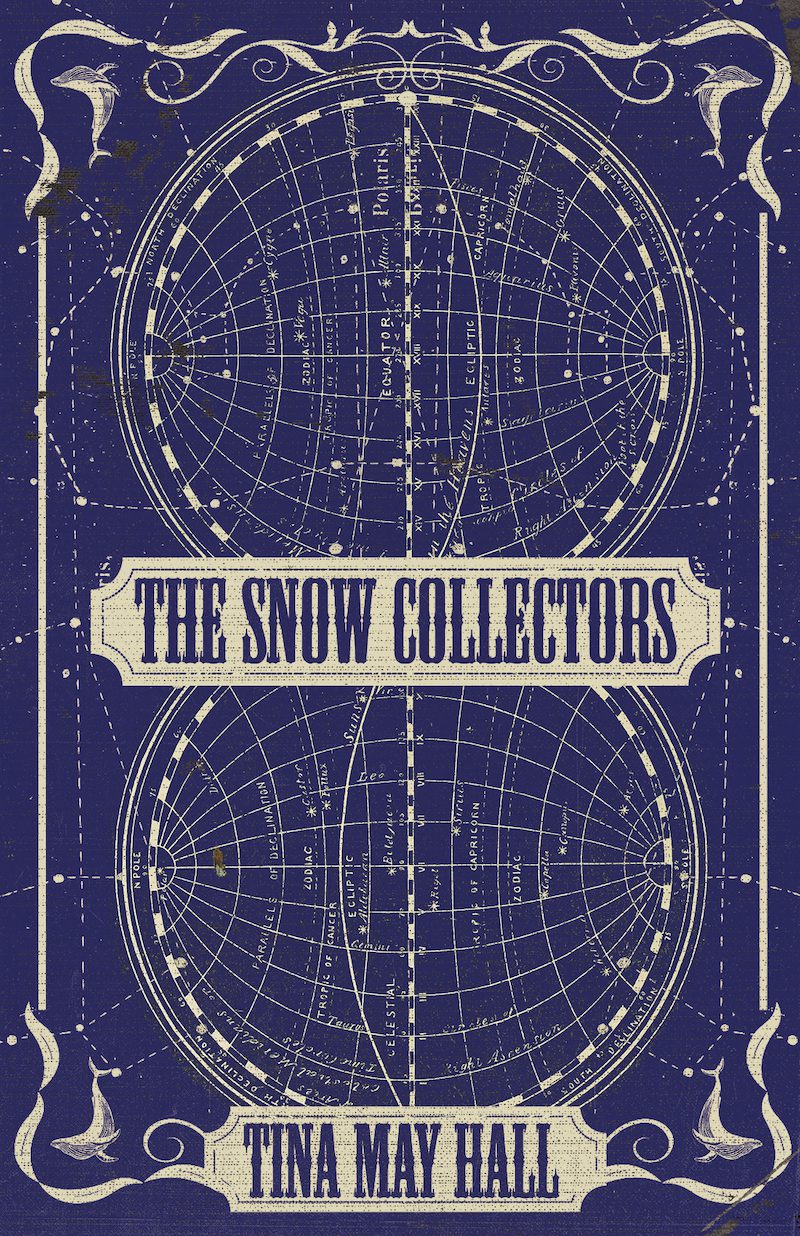
Tina May Hall’s much-anticipated debut novel, The Snow Collectors, follows her 2010 short story collection, The Physics of Imaginary Objects, which won the Drue Heinz Literature Prize, as well as her 2009 novella in prose poems, All the Day’s Sad Stories, which won the Caketrain Chapbook Competition. Both of Hall’s previous books walk the line between prose and poetry, hybridizing narrative with a scalpel’s precision of sharp, haunting sentences, and The Snow Collectors is similarly crafted. The story of a mourning scientist who stumbles upon a dead body in the snow follows Henna’s search to discover the body’s identity, a search that throws her into the now-famous history of the doomed 1845 Franklin expedition into the Artic—a history that someone clearly doesn’t want Henna to unearth.
As a reader, I was pulled into the narrative immediately—a narrative that blends mystery with the gothic, and poetry with prose—as much as I was struck on every single page by the deliberate crafting of each sentence. It’s a rare feat for a novel to be so compulsively readable and so intricately written. Every sentence in The Snow Collectors feels like a carefully chiseled ice sculpture, which is what I couldn’t help but imagine as the novel plunged me into Henna’s winter-encased world. This same quality is what made me an enormous fan of Hall’s work when I first read The Physics of Imaginary Objects and All the Day’s Sad Stories.
Hall and I recently discussed the structure of The Snow Collectors, the research process the novel required, blending genres in her work, and characterization—including how to write a compelling animal character.
***
The Rumpus: Thank you for making the time to talk about The Snow Collectors. It’s such a beautiful book, and I want to first ask about characterization. The novel’s protagonist, Henna, is a hydrologist who has lost her family at sea. She is such a fascinating, independent character and I wanted to follow her everywhere from the first page to the end. How did you dig into character development for the novel? How did you get to know Henna as your main character?
Tina May Hall: Henna’s voice was always pretty clear to me, so I just kept testing how much I could throw at her in terms of loss, both personal bereavement and then the larger, more ineffable grief of watching the world expiring. To counter that, I wanted to give her some superpowers, so I slowly figured out through trial and error that she has a semi-magical ability to dowse and loves a tall witchy lace-up boot and is an excellent researcher with a broad stubborn streak.
Rumpus: Many of the characters in the novel maintain a collection or archive of sorts—collections of snow samples, letters, records of birds of prey, a snow almanac, even a museum of pre-environmental worldwide disaster. What draws you toward exploring archival work in your fiction? How does it bind these characters together?
Hall: I love collections and clutter and strange groupings. I’m never more inspired than when I’m peering at the weird odds and ends someone has gathered up like a dam against dissolution, be it a curio cabinet full of colored glass or an archive of letters of a Victorian termagant. I think my own writing process is akin to this kind of assemblage, an accumulation of small bits that get arranged and rearranged until they make a kind of pattern.
Rumpus: The novel centers on the 1845 disappearance of Sir John Franklin’s Arctic exploration and the subsequent expeditions launched by his wife, Lady Jane Franklin, to determine what happened. How involved was your research process for The Snow Collectors?
Hall: Too involved, I’m sure! But it was so much fun to visit the Scott Polar Research Institute at Cambridge to read Jane Franklin’s journals and the National Maritime Museum in Greenwich to see the relics from the lost expedition found on the ice in the 1800s. More recently, I took a trip to Ottawa to see the new items pulled up from the vanished ships, which the Canadian government found in 2014 and 2016. And there was a lot of reading of expedition logs and poring over maps, both favorite activities. I finally had to drag myself away from the research because there is so much written about this lost expedition. It truly is one of the great mysteries of the nineteenth century, and I couldn’t be more excited that the ships were found after a century and a half of searching—though it did require some redrafting on my part.
Rumpus: The novel definitely dabbles in mystery, as Henna draws closer and closer to figuring out what happened to the dead woman and how this relates to the Franklin expedition, as well as in the gothic as Henna’s journey takes her through snow-encased landscapes and labyrinthine houses. The book is incredibly suspenseful and I couldn’t put it down. What role did exploring genre play to you while writing The Snow Collectors, as well as setting the right tone?
Hall: I knew from the beginning of this project that I wanted to play with the gothic, which is a tradition that I really love. So the challenge became how to navigate and celebrate the conventions of that genre and still do the fun indulgent stuff with lyricism and compression of language that usually motivates my writing. I don’t know if it all works out, but it was thrilling to try to push up against genre and density of language and see what strange hybrids emerged. I also became more and more interested in how environmental concerns and the rapidly changing climate might express themselves through a genre that deals in repression and hauntings and the sublime effect of nature.
Rumpus: In addition to playing with genre, the novel is also beautifully written, with some of the sharpest, most vivid sentences I’ve read: “The melted snow exuded a scent: it was the smell of starved blood and ocean voyages, and watered-down turpentine, rotting fruit, the fragrance of a thousand kisses gone stray, the dried remains of small animals in the forest, the salt of an oyster’s milk.”
What is the drafting and revision process like for you? Do such razor-sharp sentences come to you easily, or do you find that you rework sentences again and again until you get them the way you want them?
Hall: Thank you for the kind words about the writing. I wish fully realized sentences came more easily to me! I’m definitely a compulsive re-worker and fiddler and read-it-aloud-er. Fortunately, I enjoy revision and am willing to sit in one place staring at a computer screen mulling over the peaks and valleys of a sentence for unreasonably long stretches of time.
Rumpus: Landscape and setting feels particularly acute in The Snow Collectors. I could feel the deep freeze of Henna’s town and community on each page. How did you immerse yourself in the world of this novel?
Hall: Well, I am someone who grew up in the Southwest and moved to a small Northeastern village that is rife with semi-gothic trappings such as decaying old houses, and transcendent pastoral landscapes, and old-timers who know where all the skeletons are buried. So, although the novel isn’t autobiographical in its main elements—no family lost at sea or dead bodies in the backyard—I have now spent many winters submerged in snow that never seems to end but still strikes me as an entirely romantic experience.
Rumpus: Like the novel’s winterscape, the structure of the novel also feels crucial, told in discrete sections throughout chapters that end with interstitial segments of Franklin’s and Lady Jane’s story. How did you decide upon the right form for the narrative told?
Hall: I originally had lofty ambitions to have the novel be evenly split between the 1800s, focusing on Lady Jane Franklin, and the present day with Henna. Lady Jane Franklin was actually the entry point for the book, and I thought she would be the main character since she is such a fascinating, prickly, ambitious, and determined woman who traveled the world with her own iron bed, gathering up all kinds of objects and scraps of knowledge to bring home to London in between her haranguing of various constituencies to search for her lost explorer husband. However, the present-day story quickly took over. I don’t know if it was my limitations in terms of writing sustained historical fiction or if Henna’s story just became more urgent to me, but most of the research I did ended up in those brief fictional encyclopedia entries, and I’ve reconciled myself to the rather ephemeral, ghostly presence of the personages I originally thought would be the center of the novel.
Rumpus: Henna’s main companion is her deceased twin sister’s dog, Rembrandt. He too is a wonderfully well-drawn character, particularly for an animal, which I imagine can be hard to do. How did you go about developing Rembrandt’s character? For you, are there distinctions between creating humans and animals on the page, or is the process relatively similar?
Hall: I’m so glad you enjoyed Rembrandt! He began with a friend’s dog, a particularly beautiful and noble German Shepard named Lucy (so, Rembrandt’s opposite in nearly all ways) who had a great habit of running ahead in the woods and jumping out at you—it clearly brought her such joy and satisfaction to do it. I gave Rembrandt that habit but then made him ridiculous and uncouth and floppy and overweight because Henna is such a buttoned-up, reserved character in love with her own grimness. She needed some comic relief. And then Rembrandt just refused to be left behind, even when it would have made more sense for him to be shuffled off to a friend or kennel. I knew I’d found a fellow dog-lover in Michelle Dotter, the editor-in-chief of Dzanc Books, when she took such good care of Rembrandt in her suggested edits, reminding me to feed him as the plot heated up and even advocating for a larger role for him in the climactic scene.
Rumpus: Were you reading any other texts while working on The Snow Collectors, whether novels or even works of nonfiction, that felt especially helpful for writing the book?
Hall: Early on, I was most inspired by Charlotte Brontë’s Villette for the eerie atmosphere she creates. When the excellent biography, Lady Franklin’s Revenge, by Ken McGoogan came out, it made my job a lot easier, especially since Lady Jane Franklin’s handwriting is tiny and cramped and hard to decipher. In general, I’d say the novel owes the largest debt to the fantastic mid-twentieth-century gothic romances by Mary Stewart, who is a writer I adore for her gorgeous landscapes and intelligent heroines. I read those books as a teenager and still periodically revisit them to be impressed anew at how she infuses the conventions of the genre with wit and a feminist sensibility. So, I was intent on winking at those books while also working to mutate the language in (hopefully) interesting ways.
Rumpus: What are you working on now?
Hall: I’m writing a series of flash fiction pieces that take the form of exhibits in the Extinction Museum that appears in The Snow Collectors. I’m also working on a new novel that, at this point, is just a mess of tidbits about genetic manipulation and perfume-making and old, island-bound abandoned mansions.
***
Photograph of Tina May Hall by Tycho Ngo.





